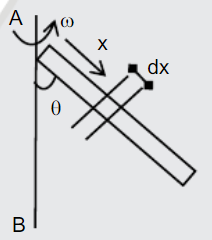The equation of a wave is given by Y=Asinω(xv−k), where ω is the angular velocity and v is the linear velocity. Find the dimension of k.
To find the dimension of k in the wave equation Y=Asin(ω(xv−k)), we need to ensure that the argument of the sine function is dimensionless. Let's break down the solution step by step:
Step 1: Understand the Argument of the Sine Function
The argument of the sine function is given by:
ω(xv−k)
For this entire expression to be dimensionless, both xv and k must have the same dimensions.
Step 2: Determine the Dimensions of xv
- x represents displacement, which has the dimension of length. Thus, the dimension of x is:
(x)=L
- v represents linear velocity, which has the dimension of length per time. Thus, the dimension of v is:
(v)=LT
- Therefore, the dimension of xv is:
(xv)=LLT=T
Step 3: Relate the Dimensions of k to xv
Since xv has the dimension of time (T), and k must have the same dimension for the argument of the sine function to be dimensionless, we conclude:
(k)=T
Step 4: Determine the Dimension of ω
- ω is the angular velocity, which is defined as the rate of change of angle with respect to time. Its dimension is:
(ω)=1T
Conclusion
Thus, the dimension of k is:
(k)=T
Final Answer
The dimension of k is T (time).
---
The argument of the sine function is given by:
ω(xv−k)
For this entire expression to be dimensionless, both xv and k must have the same dimensions.
- x represents displacement, which has the dimension of length. Thus, the dimension of x is:
(x)=L
- v represents linear velocity, which has the dimension of length per time. Thus, the dimension of v is:
(v)=LT
- Therefore, the dimension of xv is:
(xv)=LLT=T
Since xv has the dimension of time (T), and k must have the same dimension for the argument of the sine function to be dimensionless, we conclude:
(k)=T
- ω is the angular velocity, which is defined as the rate of change of angle with respect to time. Its dimension is:
(ω)=1T
Thus, the dimension of k is:
(k)=T
The dimension of k is T (time).
Topper's Solved these Questions
- BOOK - CENGAGE PHYSICS ENGLISHCHAPTER - DIMENSIONS & MEASUREMENTEXERCISE - Exercise 1.26videos
DIMENSIONS & MEASUREMENT
- BOOK - CENGAGE PHYSICS ENGLISHCHAPTER - DIMENSIONS & MEASUREMENTEXERCISE - Exercise 1.317videos
DIMENSIONS & MEASUREMENT
- BOOK - CENGAGE PHYSICS ENGLISHCHAPTER - DIMENSIONS & MEASUREMENTEXERCISE - Integer2videos
DIMENSIONS & MEASUREMENT
- BOOK - CENGAGE PHYSICS ENGLISHCHAPTER - CENTRE OF MASSEXERCISE - INTEGER_TYPE1videos
CENTRE OF MASS
- BOOK - CENGAGE PHYSICS ENGLISHCHAPTER - FLUID MECHANICSEXERCISE - INTEGER_TYPE1videos
FLUID MECHANICS
Similar Questions
The equation of a wave is given by
y=asinω[xv−k]
where ω is angular velocity and v is the linear velocity . The dimensions of k will beView SolutionThe equation of a wave is given by
y=asinω[xv−k]
where ω is angular velocity and v is the linear velocity . The dimensions of k will beView SolutionThe equation of a wave is given by
y=asin(100t−x10) where x and y are in metre an t in second, the velocity of wave isView SolutionThe linear velocity of a rotating body is given by →v=→ω×→r, where →ω is the angular velocity and →r is the radius vector. The angular velocity of a body is →ω=ˆi−2ˆj+2ˆk and the radius vector →r=4ˆj−3ˆk, then |→v| is
View SolutionThe linear velocity of a rotating body is given by →v=→ω×→r, where →ω is the angular velocity and →r is the radius vector. The angular velocity of a body is →ω=ˆi−2ˆj+2ˆk and the radius vector →r=4ˆj−3ˆk, then |→v| is-
View SolutionThe displacement of a progressive wave is represented by y=Asin(ωt−kx), where x is distance and t is time. Write the dimensional formula of (i) ω and (ii) k.
View SolutionA rod is rotating with angular velocity ω about axis AB. Find cosθ.
 View Solution
View SolutionThe equation of a simple harmonic wave is given by
y=3sinπ2(50t−x)
where x and y are in meters and x is in second .The ratio of maximum particle velocity to the wave velocity isView SolutionThe equation of a simple harmonic wave is given by
y=3sinπ2(50t−x)
where x and y are in meters and x is in second .The ratio of maximum particle velocity to the wave velocity isView SolutionThe equation of a travelling wave is,
Y=Asin2π(pt−x/5)
Then the ratio of maximum particle velocity to wave velocity is,View Solution

